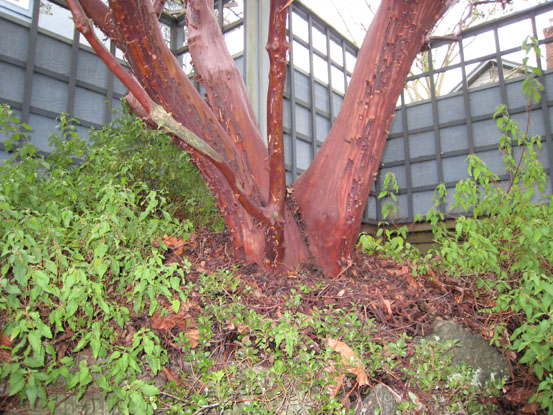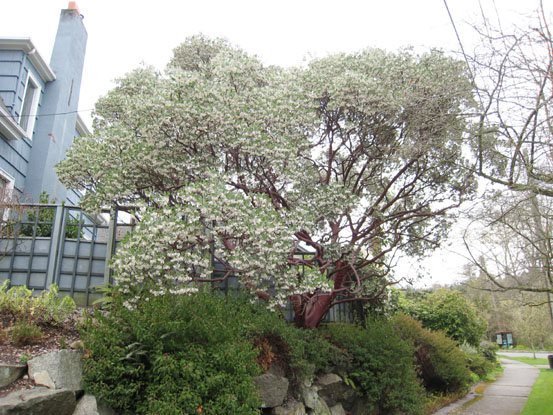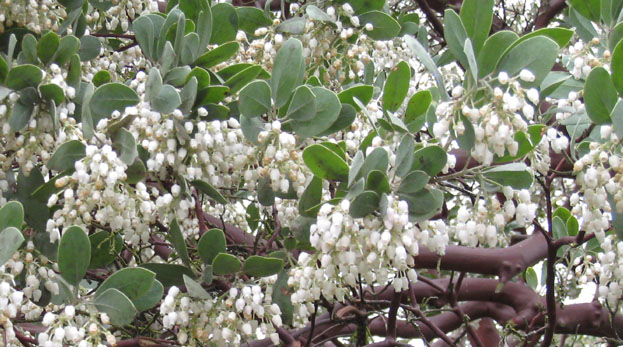Plant of the Month: March 2008
|
| Manzanita |
Arctostaphylos Manzanita Parry 1887
|
ERICACEÆ; Heath Family
|
| Some 60 species of Arctostaphylos exist, mostly in or near California. All are beautiful; most are difficult to cultivate; and few thrive for long in Seattle garden conditions. This article is an introduction. |
| The first species named in the genus Arctostaphylos grows around the northern hemisphere in cool temperate areas. It was commonly called Bearberry --as bears in Europe liked eating its fruit. So the French botanist Michel Adanson in 1763 named it Arctostaphylos Uva-Ursi. Arctostaphylos is derived from the Greek arktos (bear) and stapule (a bunch of grapes). The specific name Uva-ursi is an old generic name that also translates bear grape. |
| In the United States, Bearberry is frequently called Kinnikinnick. Manzanita is the name from Spanish-California, meaning little apples --in reference to the fruits, that when red before drying, resemble little apples. |
| Kindred genera of Arctostaphylos include Comarostaphylis (my Plant-of-the-Month December 2004 --click here), and Arbutus --the strawberry trees and madrona. |
| Arctostaphylos species vary from creeping groundcovers to small gnarly trees. All are evergreen, all make petite white or pink flowers that give rise to mealy berries. Most have thin bark that peels away, and often is singularly attractive in its red, mahogany, purple or chocolate color, contrasting with the green leaves. Newcomers seeing Manzanitas for the first time reach out to caress them. |
| John Muir, in his book The Yosemite (1912), wrote: "The knotty, crooked, angular branches are about as rigid as bones, and the red bark is so thin and smooth on both trunk and branches, they look as if they had been peeled and polished and painted." |
| Except for Bearberry, the species are accustomed to dry summers, even arid ones. They usually need and always prefer well-drained soil and full sun. Most are fire adapted; not sprouting their seeds until after a fire. Thus in nurseries their seeds are planted in ashes to further the germination rate. |
| They do not respond well to hard pruning. In gardens that have wet soil from poor drainage or summer irrigation, they are not worth trying to grow --except maybe on a built up mound of gravelly soil. And prune them modestly or not at all. They hold their leaves distinctively edgewise to the sun, thereby conserving moisture, and incidentally casting little shade. |
| In Seattle, the Bearberry is native, but about a thousand times more commonly seen planted than in its wild state. Arctostaphylos columbiana Piper (Hairy or Bristly Manzanita) used to be a rare native here, but development took out its few specimens decades ago. Planted specimens of it exist here, some 8 feet tall or so. It hybridizes with Bearberry to form intermediate shrubs; these were named Arctostaphylos x media Greene 1891. These hybrids are planted more often in Seattle than purebred Arctostaphylos columbiana. |
| Considering their appearance and garden performance in Seattle, neither Arctostaphylos columbiana nor its hybrid Arctostaphylos x media prove as attractive and healthy as some utterly non-native shrubs such as A. Manzanita, A. viscida Parry (Whiteleaf Manzanita), and the too rarely cultivated A. Andersonii Gray (Santa Cruz Manzanita). |
| The appeal of such non-natives is that they look more exotic, and are less blemished by fungal leaf spots. They have the wonderful bark, the restful, pleasingly proportioned foliage, and the flowers are a lovely bonus. The flowers are always small, in nodding clusters, and usually white, sometimes pink. A. Manzanita blooms in February, March and early April. |
| The 3 photos below show an old, planted A. Manzanita in Seattle that is 20 feet tall and 32 feet wide. It is in the Montlake neighborhood, at the corner of West Montlake Place E and E Miller Street. For all I know it may date from the 1950s or early 1960s. Under it are planted native sword ferns (Polystichum munitum), Bearberry, rockrose (Cistus salviifolius), and Aaron's Rod (Hypericum calycinum). Two street-tree Washington Hawthorns shade the manzanita's west side --if I lived there I would cut them down for its sake. After all, they are common trees, while the manzanita is rare, as well as the largest one known in the city. (In 2010 the hawthorns were cut. And in February, 2011, the Manzanita was declared an official Heritage Tree.) I do not know when this species was first cultivated in Seattle. Certainly no later than the 1940s. It had been introduced to England in 1897. |
| In the wild this species ranges from Mount Diablo, California, north through the outer Coast ranges and the Sierra Nevada foothills. In such places it gets less water than the Seattle specimen, and sets more fruit --being cross-pollinated. It is a sturdy, tough shrub of the chaparral. So the Seattle tree has grown more rapidly than it would have in a wild state. In his 1933 book Western Wild Flowers and their Stories, Charles Francis Saunders writes: "Of all the manzanitas, the Parry manzanita (Arctostaphylos manzanita), so called for Dr. C.C. Parry, who made a special study of the genus for many years, may be accorded the palm for size. There once stood near St. Helena in Napa County a specimen believed to be the largest of its race. It was reported to be 35 feet in height, with a crown of about the same diameter, and a trunk girth of 11.5 feet at the base." (p. 197). |
| According to the California Register of Big Trees, the largest specimen of Common or Big Manzanita known these days (at Chico, in 2005) is 27 feet tall, 30 feet wide, its trunk circumference 9 feet 7 inches. |
| Manzanita has economic utility besides its role as a beautiful ornamental. The berries are edible, though bland, mealy, and little favored as raw eating. Bears do like them. They can be collected dry, then ground, the hard seeds are removed, leaving a sort of flour. Or they can be made into a cider. The wood is very hard, twisted, and subject to checking and warping, so has limited uses for small specialty items. The crooked dark stems have been used in flower arranging. |
A good local mail-order nursery source for rarer species and hybrids of manzanita is Colvos Creek Nursery (www.ColvosCreekNursery.com).
Back |

Manzanita trunk photo by ALJ
|

Manzanita photo by ALJ
|

Manzanita close-up photo by ALJ
|
|
|

